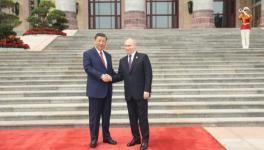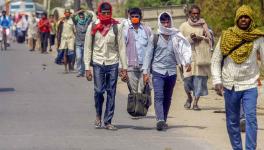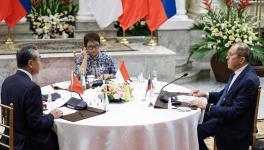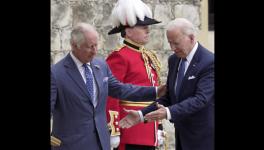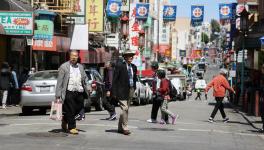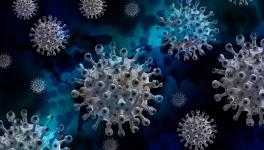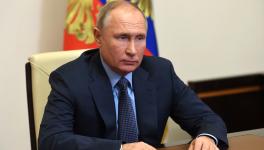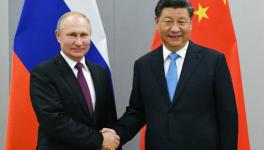Growing Xenophobia Against China in the Midst of Coronashock
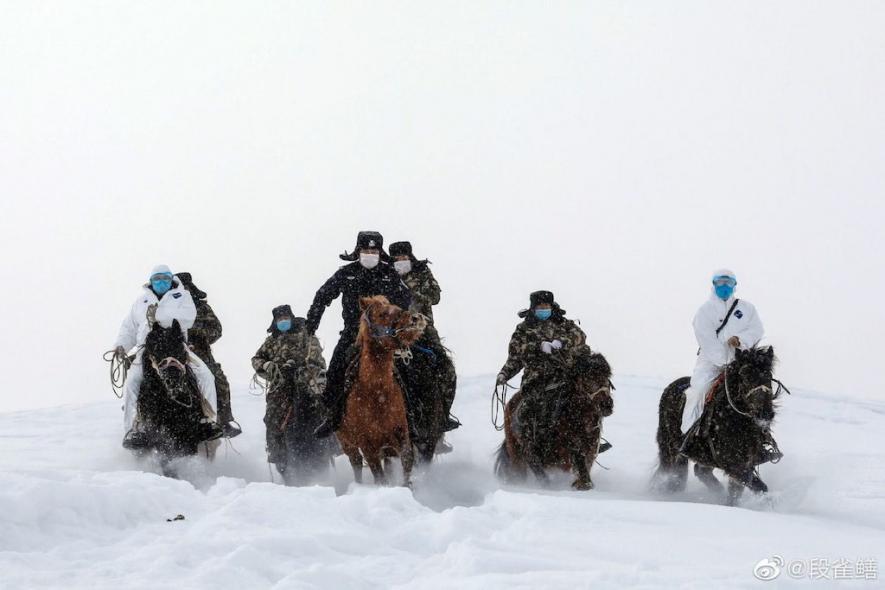
Chinese doctors in the Altai mountains.
On March 25, the foreign ministers of the G7 states failed to release a statement. The United States—the president of the G7 at this time—had the responsibility for drafting the statement, which was seen to be unacceptable by several other members. In the draft, the United States used the phrase “Wuhan Virus” and asserted that the global pandemic was the responsibility of the Chinese government. Earlier, U.S. President Donald Trump had used the phrase “Chinese Virus” (which he said he would stop using) and a member of his staff was reportedly heard using the slur “Kung Flu.” On Fox News, anchor Jesse Watters explained in his unfiltered racist way “why [the virus] started in China. Because they have these markets where they eat raw bats and snakes”. Violent attacks against Asians in the United States have spiked as a consequence of the stigma driven by the Trump administration.
Quite correctly, the World Health Organization’s Director-General Tedros Adhanom Ghebreyesus called for “solidarity, not stigma” in a speech given on February 14, long before the virus had hit Europe or North America. Ghebreyesus knew that there would be a temptation to blame China for the virus, in fact, to use the virus as a weapon to attack China in the most repulsive way. His slogan —solidarity, not stigma—was intended to sharply demarcate an internationalist and humanist response to the global pandemic from a narrow bigoted and unscientific response to the virus.
Origins
SARS-CoV-2, which is the official name for the virus, developed in the way many viruses develop: through the transmission between animals and humans. There is as yet no firm consensus about where this virus developed; one suggestion is that it developed in the west end of the Hunan Wholesale Seafood Market in Wuhan, in China’s Hubei province, where wild animals are sold. A central issue is the expansion of agriculture into forests and hinterlands, where humans have a greater chance to interact with new pathogens, such as SARS-CoV-2. But this is not the only such virus, even though it is undoubtedly the most dangerous to humans. In the recent period, we have seen a range of panzootic avian flu such as H1N1, H5Nx, H5N2 and H5N6. Even though H5N2 was known to have originated in the United States, it was not known as the “American virus” and no one sought to stigmatise the United States for it. The scientific name was used to describe these viruses, which are not the responsibility of this or that nation; the arrival of these viruses raises the more fundamental question of human encroachment into forests and the balance between human civilisation (agriculture and cities) and the wilds.
The naming of a virus is a controversial matter. In 1832, cholera advanced from British India toward Europe. It was called “Asiatic Cholera”. The French felt that since they were democratic, they would not succumb to a disease of authoritarianism; France was ravaged by cholera, which was as much about the bacteria as it is about the state of hygiene inside Europe and North America. (When cholera struck the United States in 1848, the Public Bathing Movement was born.)
The “Spanish Flu” was only named after Spain because it came during World War I when journalism in most belligerent countries was censored. The media in Spain, not being in the war, widely reported the flu, and so that pandemic took the name of the country. In fact, evidence showed that the Spanish Flu began in the United States, in a military base in Kansas where the chickens transmitted the virus to the soldiers. It would then travel to British India, where 60% of the casualties of that pandemic took place. It was never named the “American Flu” and no Indian government has ever sought to recover costs from the United States because of the animal-to-human transmission that happened there.
China and the Coronavirus
In an important article published in the medical journal The Lancet, Professor Chaolin Huang wrote, “The symptom onset date of the first patient [of SARS-CoV-2] identified was December 1, 2019.” Initially, there was widespread confusion about the nature of the virus, and whether it could be transmitted from human to human. It was assumed that the virus was one of the known viruses and that it was mainly transmitted from animals to humans.
Dr. Zhang Jixian, director of the Department of Respiratory and Critical Care Medicine of Hubei Province Hospital of Integrated Chinese and Western Medicine, was one of the first doctors to sound the alarm about the novel coronavirus pneumonia outbreak. On December 26, Dr. Zhang saw an elderly couple who had high fever and a cough—symptoms that characterize the flu. Further examination ruled out influenza A and B, mycoplasma, chlamydia, adenovirus and SARS. A CT scan of their son showed that something had partially filled the interior of his lungs. That same day, another patient—a seller from the seafood market—presented the same symptoms. Dr. Zhang reported the four patients to China’s Center for Disease Control and Prevention of the Jianghan District of Wuhan. Over the next two days, Dr. Zhang and her colleagues saw three more patients with the same symptoms who had visited the seafood market. On December 29, the Hubei Provincial Center for Disease Control and Prevention sent experts to investigate the seven patients at the hospital. On February 6, Hubei Province recognised the valuable work done by Dr. Zhang and her team in the fight to identify and reveal the virus. There was no attempt to suppress her work.
Two other doctors—Dr. Li Wenliang (an ophthalmologist from Wuhan Central Hospital) and Ai Fen (chief of the department of emergency treatment at Wuhan Central Hospital)—played a significant role in trying to break through the confusion to bring clarity toward the new virus. In the first days, when everything seemed fuzzy, they were reprimanded by the authorities for spreading fake news. Dr. Li died of the coronavirus on February 7. Major medical and government institutions—the National Health Commission, the Health Commission of Hubei Province, the Chinese Medical Doctor Association and the Wuhan government —expressed their public condolences to his family. On March 19, the Wuhan Public Security Bureau admitted that it inappropriately reprimanded Dr. Li, and it chastised its officers. Dr. Ai Fen was also told to stop spreading fake news, but in February, she received an apology and was later felicitated by Wuhan Broadcasting and Television Station.
The provincial authorities knew about the new virus by December 29. The next day, they informed China’s Center for Disease Control, and the following day, on December 31, China informed the World Health Organization (WHO), a month after the first mysterious infection was reported in Wuhan. The virus was identified by January 3; a week later, China shared the genetic sequence of the new coronavirus with WHO. It is because China released the DNA that immediate scientific work took place across the planet to find a vaccine; there are now 43 vaccine candidates, four in very early testing.
China’s National Health Commission assembled a team of experts from the Chinese Center for Disease Control and Prevention, the Chinese Academy of Medical Sciences, and the Chinese Academy of Sciences; they conducted a series of experiments on the virus samples. On January 8, they confirmed that the novel coronavirus was indeed the source of the outbreak. The first death from the virus was reported on January 11. On January 14, the Wuhan Municipal Health Commission said that there was still no evidence of human-to-human transmission, but they could not say with certainty that limited human-to-human transmission was impossible.
A week later, on January 20, Dr. Zhong Nanshan said that the novel coronavirus could be spread from human to human (Dr. Zhong, a member of the Communist Party of China, is a famous respiratory expert and a leading person in the fight against SARS in China). Some medical workers were infected by the virus. That day, Chinese President Xi Jinping and Premier Li Keqiang instructed all levels of government to pay attention to the spread of the virus; the National Health Commission and other official bodies were told to begin emergency response measures. Wuhan went into full lockdown on January 23, three days after human-to-human transmission of this virus was established. The next day, Hubei province activated its Level-1 alert. On January 25, Premier Li assembled a coordinating group. He visited Wuhan two days later.
It is unclear if China could have done anything different as it faced an unknown virus. A WHO team that visited China from February 16 to 24 praised the government and the Chinese people in its report for doing their utmost to stem the spread of the virus; thousands of doctors and medical personnel arrived in Wuhan, two new hospitals were built for those infected by the virus, and various civic bodies went into action to assist families under lockdown. What the Chinese authorities did to stem the rise of the infections—as a major new study shows—was to put those infected in hospitals and those who had been in touch with them into quarantine. This targeted policy was able to identify those who had been in the chain of infection and thereby break the chain.
The World and China
The Indian state of Kerala’s Health Minister K. K. Shailaja followed the rise of the cases in Wuhan and began emergency measures in this state of 35 million people in India. She did not wait. What China was doing taught Shailaja and her team how to respond. They were able to contain the virus in this part of India.
The United States was informed about the severity of the problem early. On New Year’s Day, the Chinese Center for Disease Control officials called Dr. Robert Redfield, head of the U.S. Centers for Disease Control and Prevention, while he was on vacation. “What he heard rattled him,” wrote the New York Times. Dr. George F. Gao, the head of the Chinese CDC, spoke to Redfield days later, and Dr. Gao “burst into tears” during the conversation. This warning was not taken seriously. A month later, on January 30, U.S. President Donald Trump took a very cavalier position. “We think it’s going to have a good ending for us,” he said of the coronavirus. “That I can assure you.” He did not declare a national emergency till March 13, by which time the virus had begun to spread in the United States.
Others around the world were as cavalier. They were like the French politicians of 1832 who felt that France would not be affected by “Asiatic cholera”. There was no such thing as Asiatic cholera in 1832, but only cholera that would harm people with poor hygienic systems. In the same way, there is no such thing as a Chinese virus; there is only the SARS-CoV-2. The Chinese people showed us the way to confront this virus, but only after some trial and error on their part. It is time to learn that lesson now. As the WHO says, “test, test, test,” and then carefully calibrate lockdowns, isolations, and quarantine. Chinese doctors who developed expertise in fighting the virus are now in Iran, Italy, and elsewhere, bringing the spirit of internationalism and collaboration with them.
On March 4, Dr. Bruce Aylward, who led the WHO team to China, was interviewed by the New York Times. When asked about the Chinese response to the virus, he said, “They’re mobilised, like in a war, and it’s fear of the virus that was driving them. They really saw themselves on the frontlines of protecting the rest of China. And of the world.”
(This is the first part of a three-part series, which will be fully available here.)
This article was produced by Globetrotter, a project of the Independent Media Institute.
Vijay Prashad is an Indian historian, editor and journalist. He is a writing fellow and chief correspondent at Globetrotter, a project of the Independent Media Institute. He is the chief editor of LeftWord Books and the director of Tricontinental: Institute for Social Research.
Du Xiaojun works as a translator and is based in Shanghai. His research is in international relations, cross-cultural communication, and applied linguistics.
Weiyan Zhu is a lawyer based in Beijing. She is interested in social and political issues.
Get the latest reports & analysis with people's perspective on Protests, movements & deep analytical videos, discussions of the current affairs in your Telegram app. Subscribe to NewsClick's Telegram channel & get Real-Time updates on stories, as they get published on our website.










